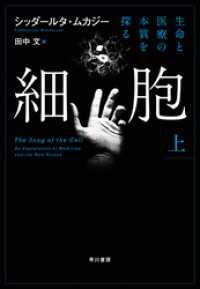- ホーム
- > 洋書
- > 英文書
- > Politics / International Relations
Full Description
Lu Ning, former assistant to a vice-foreign minister of China, draws on archival materials, interviews, and personal experiences, to provide unique insights into the formal and informal structures, processes, mechanisms, and dynamics of--and key players in--foreign-policy decisionmaking in Beijing. Lu Ning sheds light on controversial decisions that were made, such as China's entering the Korean War, selling DF-3 missiles to Saudi Arabia in 1986, and cooperating with the Israeli defense establishment.Lu Ning divulges the inner workings of Beijing's foreign ministry, introduces new Chinese language sources, and presents a series of case studies that challenge existing Western theoretical analysis of Chinese policymaking. Based on his examination of the past forty years, Lu Ning makes predictions about likely changes in Beijing's leadership and in its foreign-policy decisionmaking process. This accessibly written, incisive book will be invaluable to anyone interested in Sinology, Chinese foreign policy, comparative foreign policy, and contemporary international relations of East Asia.This second edition contains a fully revised Introduction, and it has been updated through President Clinton's recent visit to China. The new edition also contains new material on the Clinton Administration's varying policy positions toward China.
Contents
* List of Acronyms * Acknowledgments * Introduction: An Emerging Giant? * The Foreign Affairs Structure * An Overview of the Political Power Structure * The Foreign-Policy Decisionmaking Structure, * Decisionmaking Methodology * The Organization and Processes of the Ministry of Foreign Affairs * The Anatomy of a Bureaucracy: The MFA * Policy Initiation, Coordination, and Subversion * The History and Political Culture of the Ministry of Foreign Affairs * History of the Ministry of Foreign Affairs and the Cadres Corps * The Political Culture * Main Actors: The Central Leadership * The Mao Era * The Deng Era * Conclusion * Main Actors: Institutions and Individuals * Foreign Affairs Institutions * Individual Bureaucrats and Researchers * Changing Dynamics in Foreign-Policy Decisionmaking * Foreign-Policy Decisionmaking in the Era of Mao * Foreign-Policy Decisionmaking in the Deng Era * Western Theories and Chinese Practices * The Classical School * The Institutional School * Theory and Practice: A Summary * Appendix I: Foreign-Policy Decisionmaking Structure * Appendix II: The Foreign Affairs Office of the State Council * Appendix III: The Ministry of Foreign Affairs * Appendix IV: The Ministry of Foreign Trade and Economic Cooperation (MOFTEC) * Appendix V: The Hong Kong and Macau Affairs Office of the State Council (HMAO) * Appendix VI: The Taiwan Affairs Office of the State Council (TAO) * Appendix VII: The Overseas Chinese Affairs Office of the State Council (OCAO) * Appendix VIII: Xinhua News Agency * Bibliography * About the Book and Author * Index
-

- 電子書籍
- Pythonによるアルゴリズムとデータ…
-

- 電子書籍
- 細胞―生命と医療の本質を探る― 上
-

- 電子書籍
- ギャルゲーの女主人公になった私と攻略対…
-

- 電子書籍
- 始皇帝完全ビジュアルガイド
-

- 電子書籍
- 反逆者の花嫁 愛の生まれる町 ハーレク…



